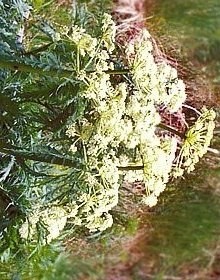Molopospermum peloponnesiacum
(Molopospermum peloponnesiacum)

Description
Species of the plant which is Molopospermum peloponnesiacum. It was first described by Carl von Linné, and given the exact name of Wilhelm Daniel Joseph Koch. Molopospermum peloponnesiacum belongs to the genus Molopospermum, and family Apiaceae. Molopospermum is a monotypic genus of flowering plants belonging to the family Apiaceae. The single species, Molopospermum peleponnesiacum, Spanish: cuscullo, French couscouil and Rousillonais Catalan coscoll is native to the mountains of Spain, southern France and Italy (notably the Pyrenees and the Alps) and is edible, being used in ways similar to its better-known fellow umbellifers celery and angelica and also believed to have tonic properties. M. peleponnesiacum is a rather stout and strongly aromatic perennial umbellifer, attaining 100-150cm in height and forming a mound of glossy, intricately divided and rather jaggedly cut foliage, above which are borne, in late Spring, umbels of flowers which are initially yellow in colour, turning gradually to cream, followed by brown, deeply ribbed, paired fruits (mericarps) resembling seeds. The foliage, while attractive, is rather short-lived, beginning to die down in late summer. The genus name is a combination of the Greek elements μολοψ (molops) "bruise" and σπέρμα (sperma) "seed" yielding the meaning of "bruised-seed" - in reference not, as might be assumed, to the fruits being used to treat bruises, but to the long, deep grooves in the fruits resembling bruises - i.e. dents or furrows. The specific name peleponnesiacum is likewise misleading, appearing to suggest that the plant hails from the Peloponnese peninsula of southern Greece, which is not the case: the geographical epithet 'peleponnesiacum' was applied to the plant in error by the founding father of modern botany Linnaeus, who mistakenly believed the plant to be native to Greece. Linnaeus's error was noted by both Lamarck and de Candolle, who were unable to find the plant in Greece, but, despite the condemnation of these and subsequent botanists, the name has stuck, never having been replaced by a more appropriate one. Like a number of other robust umbellifers, the species is sometimes grown as an 'architectural plant', its shiny, fern-like foliage and attractive umbels of flowers lending an interesting textural element to the herbaceous border in early summer.
Taxonomic tree:







